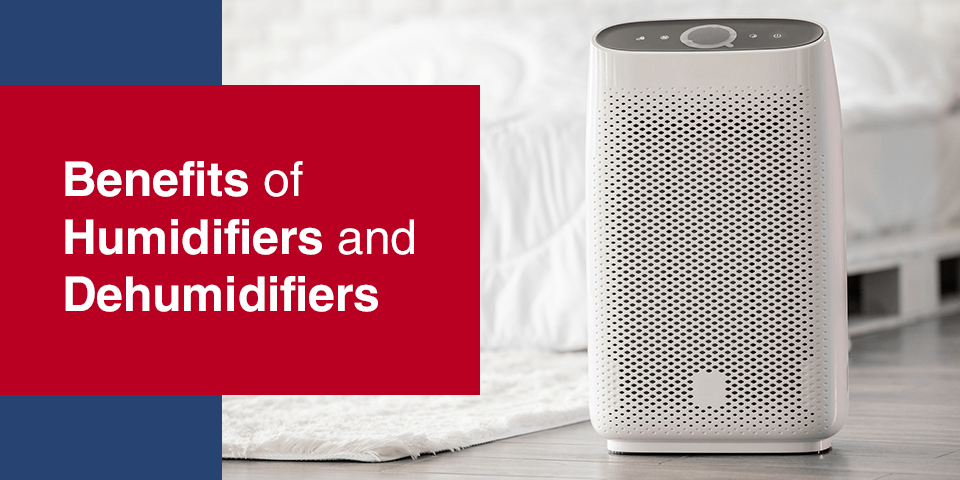
Benefits of Humidifiers and Dehumidifiers
Both humidifiers and dehumidifiers can make your home more comfortable. However, you must know the differences and benefits to determine the best choice for your home and health. Find out how to choose between a dehumidifier and a humidifier and when you would need to use either.
What Is a Humidifier? What Are the Uses of a Humidifier?
A humidifier adds moisture to dry air to help you to attain the ideal humidity range for comfort and health, which is between 30% and 50%. When the humidity drops below this level, you may experience dry nasal passages and skin or itchy eyes.
Humidifiers are available in several forms that treat the air in spaces ranging from a room to your whole home. A central humidifier connects to your home’s HVAC system and increases the humidity of all the air in your home for maximized comfort during the winter. Console or portable humidifiers treat individual rooms. You can easily move portable units to where you want to increase humidity levels.
Unfortunately, cool mist humidifiers, such as an impeller or an ultrasonic model, can create health problems not encountered with other types of humidifiers. These types of cool mist humidifiers can send minerals and microorganisms from standing water in their tanks into the air, leading to potential lung inflammation. Other types of humidifiers – steam and evaporative models – do not create this danger.
To reduce the hazards of using a humidifier, choose a central model over a portable one. If you use a portable cool mist model, you will need to also purchase distilled water for it and clean it after every use. Central humidifiers only require cleaning once or twice a year and do not create the same dangers from bacteria that cool mist models present.
What Is a Dehumidifier? When Do You Use a Dehumidifier?
Sometimes, the humidity can get too high. When humidity rises above 50%, problems may arise, such as stuffiness in the air and condensation on surfaces. Surface condensation can lead to bacteria and mildew growth while also promoting an increase in dust mites. Mildew, bacteria and dust in the air can exacerbate asthma and allergies. Plus, mildew and mold can cause structural damage to your home.
In warm weather, using an air conditioner will dehumidify the home. However, when the weather outside is too cold for the cooling factor of an air conditioner, you need a dehumidifier, which draws moisture out of the air without making the space feel colder, making them ideal for controlling the humidity in damp, cold basements.
A dehumidifier works by drawing air in and cooling it down. Because colder air takes up less space, the water droplets condense out of the air.
What Are the Health Benefits of Humidifiers and Dehumidifiers?
Depending on your health conditions, you could see relief by using a humidifier or dehumidifier. In fact, due to changing humidity levels throughout the year, you may require both to get the healthiest conditions inside your home all year long.
Health Benefits of a Humidifier
Humidifiers control excessively dry conditions. For those plagued with chapped lips, dry skin, nosebleeds, colds, bronchitis or asthma, increasing the air’s humidity can make it easier to breathe and more soothing to the skin.
The extra moisture in the air prevents your skin from drying out too much, helping conditions such as chapped lips, eczema and nosebleeds. You may not need as many moisturizing products to control these conditions when you have a home with well-regulated humidity levels.
Breathing problems such as asthma, coughs and pneumonia may worsen when the air becomes too dry because the arid conditions dry out your airways and cause irritation. Using a humidifier can ease this irritation and the discomfort it causes.
Health Benefits of a Dehumidifier
Dehumidifiers can also help with health problems. If you find that you seem to have allergies all year long, you may have a sensitivity to dust mites in your home, which thrive in high humidity. Dust mites have bodies composed of 75% water and thrive when humidity levels are at least 65%. Therefore, dry conditions can reduce their numbers. When humidity is below 65%, dust mites lose water from their bodies. When humidity levels drop below 50%, into the range recommended for home health and comfort, their numbers drop significantly due to reduced reproduction and survival. Getting rid of dust mites may ease your allergy symptoms.
If you have asthma, you don’t want the air to be too moist or too dry. Excessive moisture can make air harder to breathe, worsening asthma symptoms.
Keeping humidity levels in check will also prevent mold and mildew growth in your home, which could trigger allergies in some people.

How to Decide Whether You Need a Humidifier or Dehumidifier
To decide whether you need a humidifier or a dehumidifier, use a hygrometer around your home. This device measures the amount of moisture in the air and gives the value and relative humidity percentage. The air’s moisture levels may change depending on the weather outside, the time of year and your location in the home.
If you notice values that are lower than 30% regularly, you need a humidifier. However, if you have some parts of your home, such as the basement or attic, where values are above 50%, you should invest in a dehumidifier. Many homes will need both to keep humidity levels comfortable throughout the year.
Other signs that you may need a humidifier include turning the heat higher in the winter to feel comfortable, noticing dry wooden furnishings or instruments and health problems related to dry air. While using portable humidifiers may help, these do not shut off when the humidity gets too high, which can lead to mildew, mold and dust mite growth. A whole-home humidifier avoids the problems of a portable unit by maintaining humidity levels between 30% and 50%.
Indications that your home may need a dehumidifier include mildew, condensation on surfaces, mold, the smell of moisture in the air or clothes taking too long to air dry in your home. Dehumidifiers will remove the extra moisture from the air that causes these issues.

Contact Ranck for Indoor Air Quality Services
Too much moisture in the air or not enough can lead to health problems, especially for those with allergies and asthma. Installing a humidifier or dehumidifier in your home can make the indoor air healthier and your home more comfortable. To get the greatest benefits throughout your home and to avoid the hazards of smaller cool mist humidifiers, choose a whole-home model from Ranck to improve your indoor air quality with healthy air solutions. We also have solutions to dry out damp basements, which can further improve your health.
Contact us at Ranck for more information about our options for improving your home’s indoor air quality to make it a healthier, more comfortable place for you and your family.